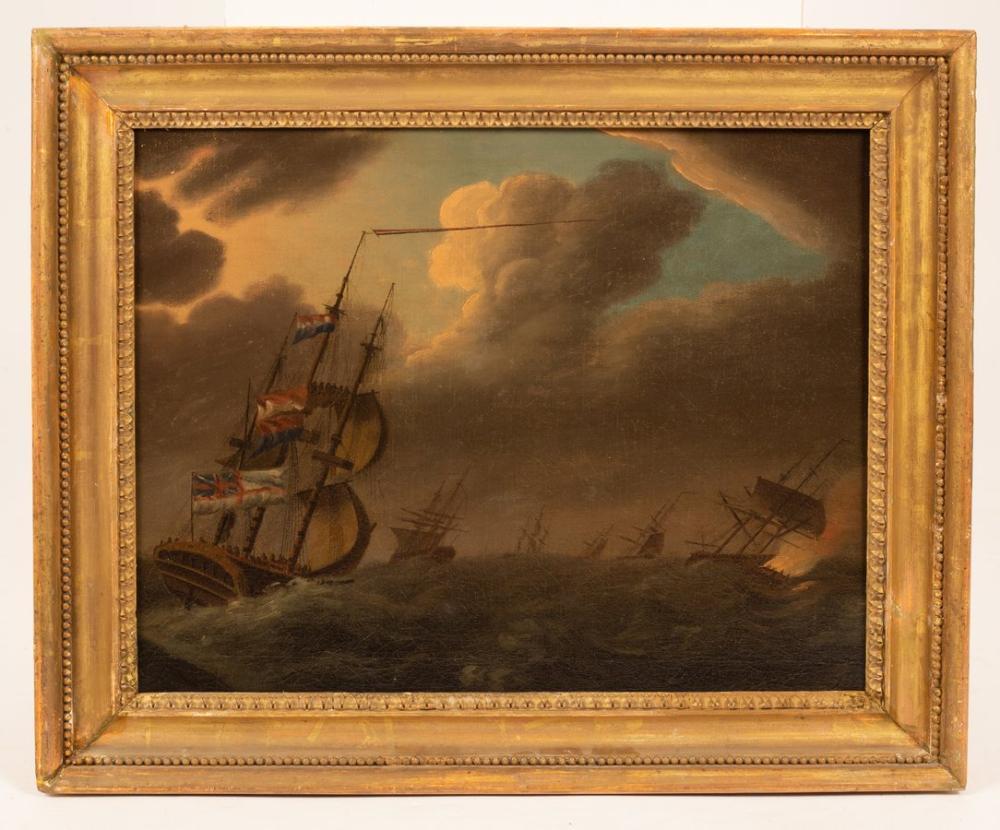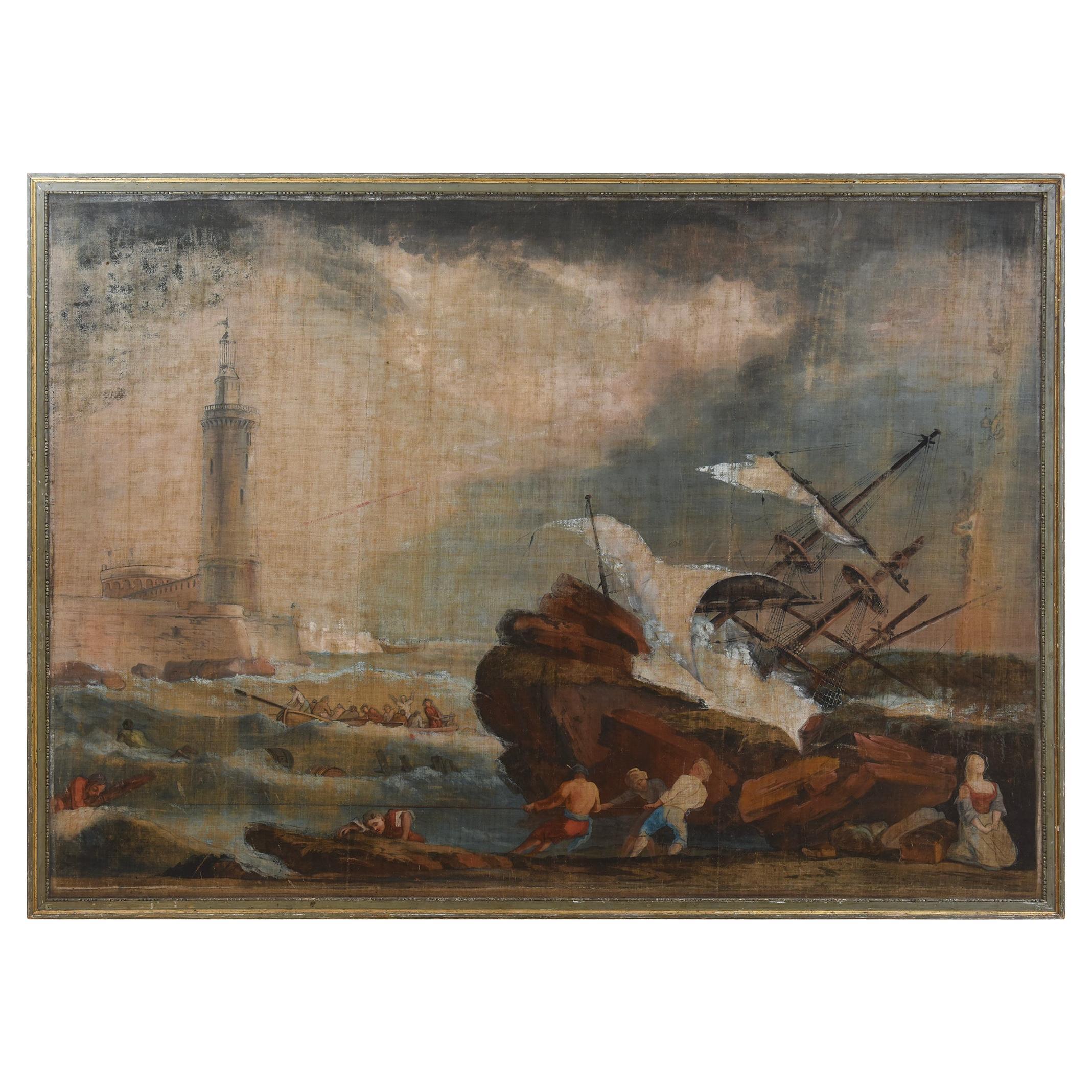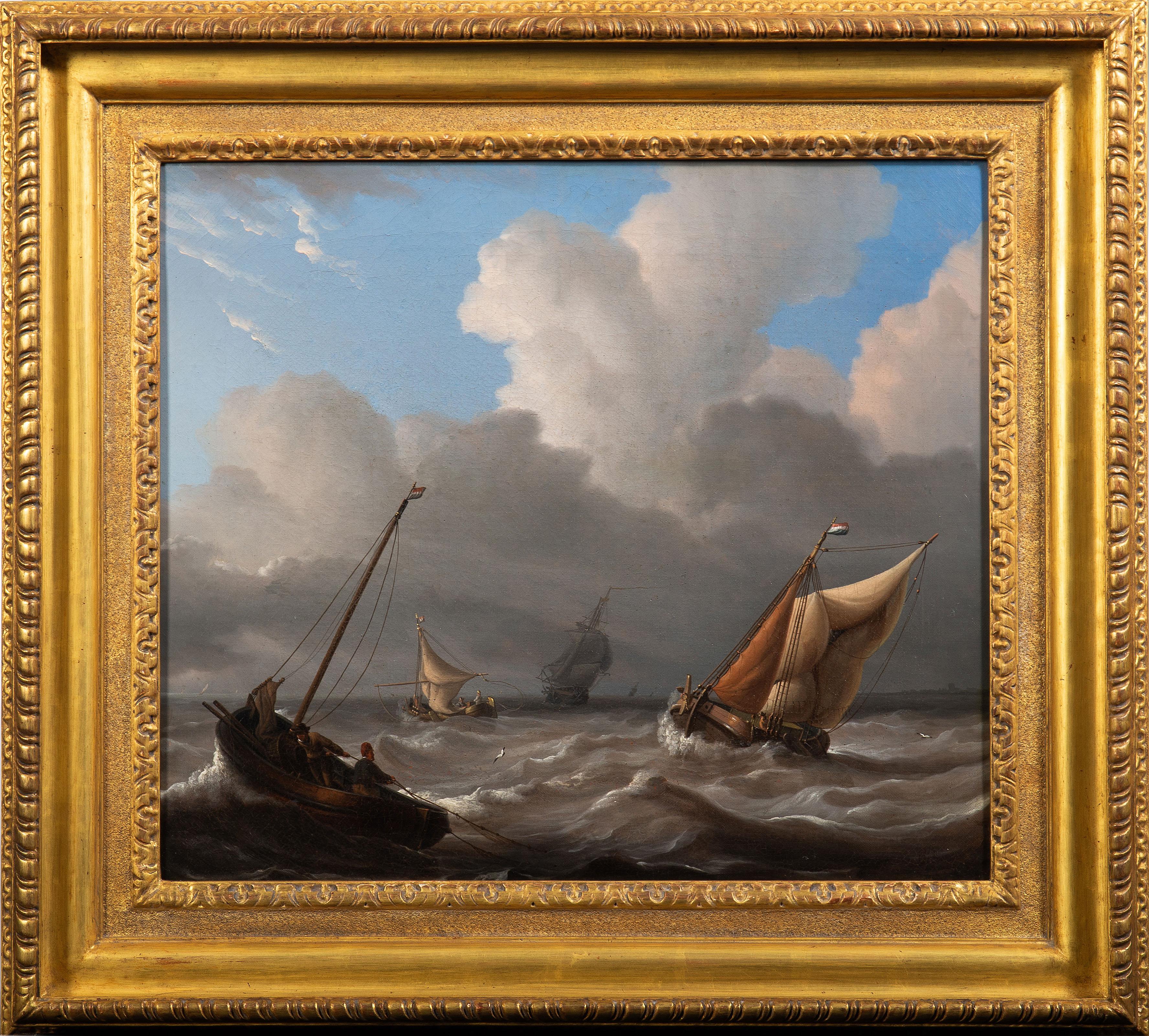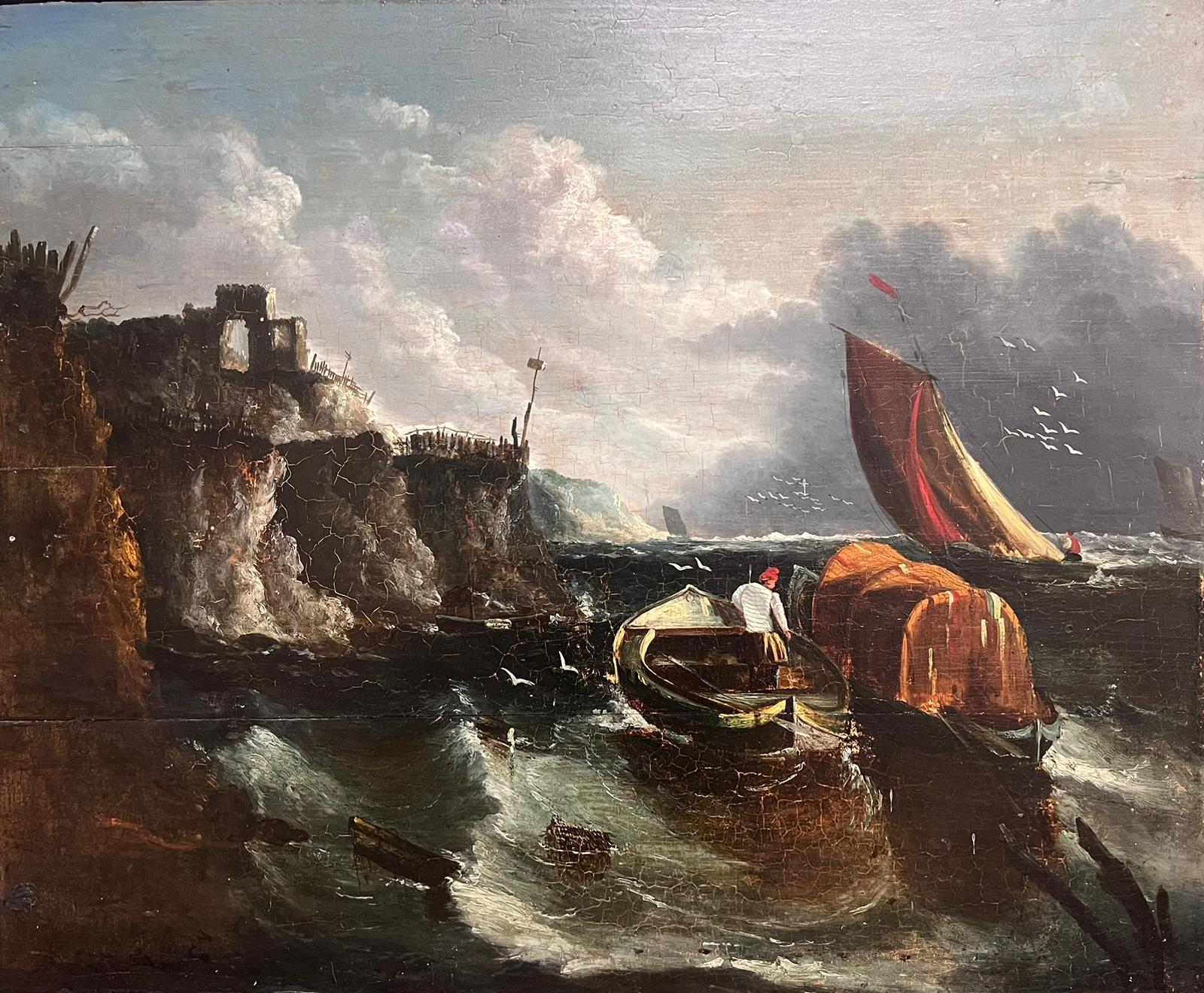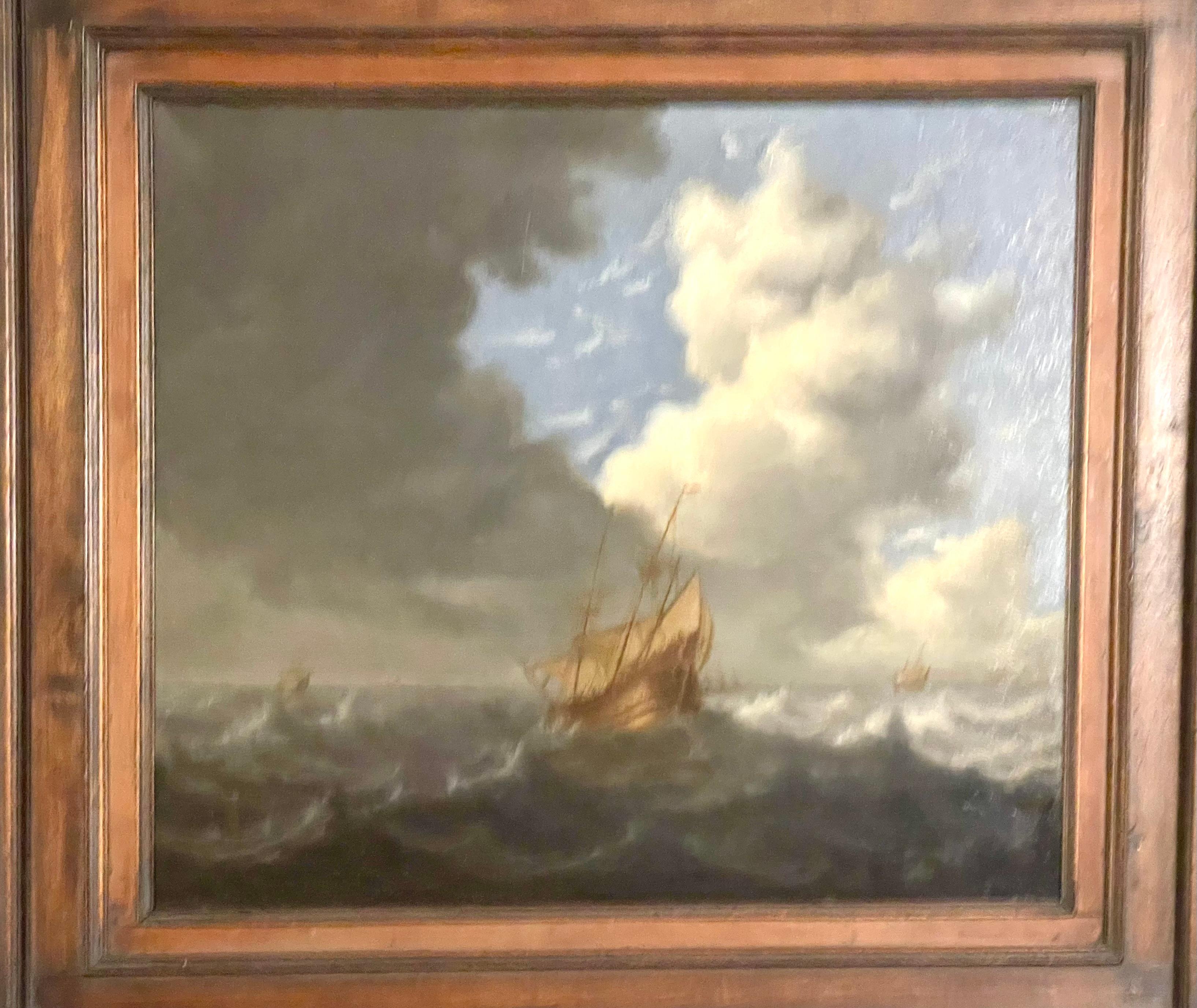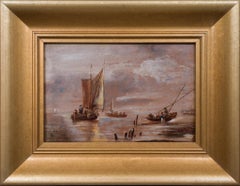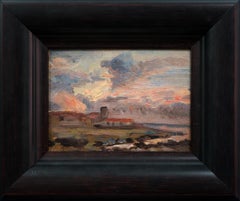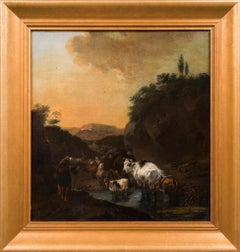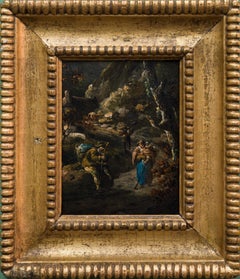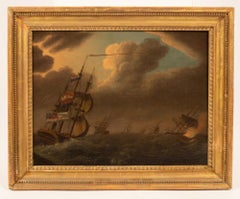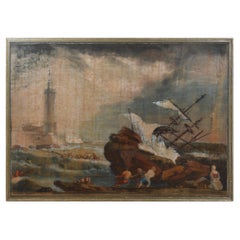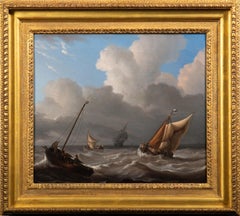Items Similar to Shipping in Stormy Waters, Attributed to Italian Artist Francesco Guardi
Video Loading
Want more images or videos?
Request additional images or videos from the seller
1 of 13
Shipping in Stormy Waters, Attributed to Italian Artist Francesco Guardi18th Century
18th Century
$47,666.73
$70,484.6432% Off
£34,760.77
£51,400.6432% Off
€39,900
€59,00032% Off
CA$65,207.14
CA$96,421.5832% Off
A$72,968.62
A$107,898.4632% Off
CHF 38,100.78
CHF 56,339.5032% Off
MX$897,073.19
MX$1,326,499.2132% Off
NOK 480,685.31
NOK 710,787.8032% Off
SEK 452,322.50
SEK 668,847.8132% Off
DKK 303,638.28
DKK 448,988.9432% Off
Shipping
Retrieving quote...The 1stDibs Promise:
Authenticity Guarantee,
Money-Back Guarantee,
24-Hour Cancellation
About the Item
The splendour of the tragic sea
Francesco Guardi and maritime painting in Venetian art
No Venetian painter was a stranger to the sea. After all, Venice was not only one of the most prominent ports of the Mediterranean, but indeed a city literally submerged in the ocean from time to time. Curiously however, the famous Venetian school of painting showed little interest in maritime motifs, favouring scenes from the iconic architecture of the city rather than seascapes. That is why this painting is a particularly interesting window into not only the painter Francesco Guardi himself – but to the significance of the element of water in art history, in absence as well as in the centre of attention.
Whether it be calm, sunny days with stunning views of the palaces alongside the canals of Venice or – more rarely – stormy shipwrecking tragedies at sea, water as a unifying element is integral to the works of painter Francesco Guardi (1712–1793). During his lifetime, Venetian art saw many of its greatest triumphs with names like Tiepolo or Canaletto gaining international recognition and firmly establishing Venice as one of the most vibrant artistic communities of Europe. While the city itself already in the 18th century was something of an early tourist spot where aristocrats and high society visited on their grand tour or travels, the artists too contributed to the fame and their work spread the image of Venice as the city of romance and leisure to an international audience, many of whom could never visit in person.
Still today, the iconic image of Venice with its whimsical array of palaces, churches and other historic buildings is much influenced by these artists, many of whom have stood the test of time like very well and remain some of the most beloved in all of art history. It was not primarily subtility, intellectual meanings or moral ideals that the Venetian art tried to capture; instead it was the sheer vibrancy of life and the fast-paced city with crumbling palaces and festive people that made this atmosphere so special. Of course, Venice could count painters in most genres among its residents, from portraiture to religious motifs, history painting and much else. Still, it is the Vedutas and views of the city that seems to have etched itself into our memory more than anything else, not least in the tradition of Canaletto who was perhaps the undisputed master of all Venetian painters.
Born into his profession, Francesco lived and breathed painting all his life. His father, the painter Domenico Guardi (1678–1716) died when Francesco was just a small child, yet both he and his brothers Niccolò and Gian Antonio continued in their fathers’ footsteps. The Guardi family belonged to the nobility and originated from the mountainous area of Trentino, not far from the Alps. The brothers worked together on more challenging commissions and supported each other in the manner typical of family workshops or networks of artists. Their sister Maria Cecilia married no other than the artist Giovanni Battista Tiepolo himself, linking the family to the most renowned Venetian name of the time. During almost a decade, Guardi worked in the studio of Michele Giovanni Marieschi, sometimes simply known as Michiel, a painted similar in both style and motif. Canaletto is, however, the artist Guardi is most often compared to since they shared a mutual fascination for depicting the architecture and cityscape of Venice.
During the course of his career, Guardi tried his hand in many different genres. He was as swift in painting landscapes, Vedutas of Venice, sacred motifs, interiors and architectural compositions as he was in a number of other motifs. His style is typical of the Venetian school but also distinct and personal once we look a little closer. There is an absolute certainty in the composition, the choice of which sometimes feels like that of a carefully calculated photograph – yet it is also very painterly, in the best sense of the word: fluid, bold, sensitive and full of character. The brushwork is rapid, intense, seemingly careless and extraordinarily minute at the same time; fresh and planned in a very enjoyable mixture. His interiors often capture the breath-taking spacious glamour of the palaces and all their exquisite decor. He usually constructed the motif through remarkably simple, almost spontaneous yet intuitively precise strokes and shapes. The result was a festive, high-spirited atmospheric quality, far away from the sterile and exact likeness that other painters fell victim to when trying to copy Canaletto.
The painting here has nothing of the city of Venice in it. On the contrary, we seem to be transported far away into the solitary ocean, with no architecture, nothing to hold on to – only the roaring sea and the dangerous cliffs upon which the ships are just moments away from being crushed upon. It is a maritime composition evoking both Flemish and Italian precursors, in the proud tradition of maritime painting that for centuries formed a crucial part of our visual culture.
This genre of painting is today curiously overlooked, compared to how esteemed and meaningful it was when our relationship to the sea was far more natural than it is today. When both people and goods travelled by water, and many nations and cities – Venice among them – depended entirely on sea fare, the existential connection to the ocean was much more natural and integrated into the imagination. The schools and traditions of maritime art are as manifold as there are countries connected to the sea, and all reflect the need to process the dangers and wonders of the ocean.
It could symbolize opportunity, the exciting prospects of a new countries and adventures, prospering trade, beautiful scenery as well as war and tragedy, loss of life, danger and doom. To say that water is ambivalent in nature is an understatement, and these many layers were something that artists explored in the most wondrous ways. Perhaps it takes a bit more time for the modern eye to identify the different nuances and qualities of historic maritime paintings, they may on first impression seem hard to differentiate from each other. But when allowing these motifs to unfold and tell stories of the sea in both fiction and reality – or somewhere in between – we are awarded with an understanding of how the oceans truly built our world.
In Guardi’s interpretation, we see an almost theatrically arranged shipwrecking scene. No less than five ships are depicted right in the moment of utter disaster. Caught in a violent storm, the waves have driven them to a shore of sharp cliffs and if not swallowed by the waves, crushing against the cliffs seems to be the only outcome. The large wooden ships are impressively decorated with elaborate sculpture, and in fact relics already during Guardi’s lifetime. They are in fact typical of Dutch and Flemish 17th century ships, giving us a clue to where he got the inspiration from. Guardi must have seen examples of Flemish maritime art, that made him curious about these particular motifs. One is reminded of Flemish painters like Willem van de Velde and Ludolf Backhuysen, and this very painting has indeed been mistakenly attributed to Matthieu van Plattenberg. It bears, however, all the typical traits of Guardi and knowing his impressive versatility further strengthens the attribution to him, as do no less than ten other known versions of the same scene and a study drawing. Both the versions in Musée des Beaux-Arts in Montreal and the Gnecchi collection in Milan are particularly similar in their dramatic impact, treatment of the waves and positionings of the ships, together forming an interesting example of how one artist could rework and explore a composition.
Even though seascapes never became the speciality of Guardi, the existence of this painting is an intriguing testament to his virtuosity, and artistic advantages of using the sea as a metaphor for the fragility of life and man’s vulnerability against the elements. Furthermore, it gives greater depths to the understanding of the entire school of Venetian painting which, for all its iconic architectural splendour, was much more versatile than was is commonly assumed. The fact that artworks like these also remind us about a forgotten relationship to the sea further enhances the valuable lesson that a painting can be an eye-opener to history, once we give it the attention it deserves.
oil on canvas
canvas dimensions 20 x 23 ½ in. (50.8 x 59.7 cm.)
frame 25.7 x 29 inches (65.5 x 74 cm.)
Provenance:
Christie's London, 2 November 2016, lot 180 (as Attributed to Francesco Guardi), sold for GBP 102.500;
Private collection France;
Sotheby’s Paris, 17 June 2021, lot 165 (as Attributed to Francesco Guardi)
Literature:
A. Bonfand, Francesco Guardi, una burrasca, étude inédite, 2017, cat. 15 as by Francesco Guardi, fig. 1.
J. Byam Shaw, The Drawings of Francesco Guardi, London, 1951, p. 78, no. 73, illustrated.
A preparatory sketch for this composition is recorded by Byam Shaw. In several respects this drawing is closer to this painting than to the two versions of this composition by Guardi in the Museum of Fine Arts, Montreal and the Bortolotto collection. The design of the stern of the ship far right is different than in the Montreal picture, the crows nests are depicted at sharper angles and the cliffs along the right edge are more prominently displayed in the drawing and this lot. In the drawing the man standing on the rock has his arms outstretched and is trying to catch the rigging: in this picture he has already caught this.
- Attributed to:Francesco Guardi (1712 - 1792, Italian)
- Creation Year:18th Century
- Dimensions:Height: 25.79 in (65.5 cm)Width: 29.14 in (74 cm)
- Medium:
- Movement & Style:
- Period:
- Condition:Overall good condition, ready to hang. The canvas has been relined. There is surface dirt and the varnish has discoloured yellow. There is a fine pattern of craquelure to the paint surface. Contact us for a complete condition report.
- Gallery Location:Stockholm, SE
- Reference Number:Seller: CA21441stDibs: LU144529797932
About the Seller
5.0
Platinum Seller
Premium sellers with a 4.7+ rating and 24-hour response times
Established in 2020
1stDibs seller since 2020
185 sales on 1stDibs
Typical response time: <1 hour
Associations
International Confederation of Art and Antique Dealers' Associations
- ShippingRetrieving quote...Shipping from: Stockholm, Sweden
- Return Policy
Authenticity Guarantee
In the unlikely event there’s an issue with an item’s authenticity, contact us within 1 year for a full refund. DetailsMoney-Back Guarantee
If your item is not as described, is damaged in transit, or does not arrive, contact us within 7 days for a full refund. Details24-Hour Cancellation
You have a 24-hour grace period in which to reconsider your purchase, with no questions asked.Vetted Professional Sellers
Our world-class sellers must adhere to strict standards for service and quality, maintaining the integrity of our listings.Price-Match Guarantee
If you find that a seller listed the same item for a lower price elsewhere, we’ll match it.Trusted Global Delivery
Our best-in-class carrier network provides specialized shipping options worldwide, including custom delivery.More From This Seller
View AllMaritime Scene with Sailboats
Located in Stockholm, SE
This captivating maritime painting, likely the work of an English artist, dates to the late 19th century and showcases a masterful command of light and texture. The composition featu...
Category
Late 19th Century Romantic Figurative Paintings
Materials
Oil, Board
Coastal Landscape with Dramatic Clouds
Located in Stockholm, SE
We are pleased to offer a captivating small oil painting by the Swedish artist Georg Stoopendaal. Despite its modest dimensions of 14 x 18.5 cm, this piece exudes a powerful presence...
Category
1920s Post-Impressionist Landscape Paintings
Materials
Oil, Board
$2,269 Sale Price
24% Off
Shepherd with Sheep, Cows and a Goat in a Landscape by Jan Frans Soolmaker
Located in Stockholm, SE
This painting depicts a pastoral scene that is attributed to the artist Jan Frans Soolmaker, an artist known for his Italianate landscapes and scenes that often feature equestrian and Arcadian elements. The painting is not signed but is attributed to Soolmaker, relating it to a known signed work by the artist that was sold at Sotheby’s London in 1999.
The scene is suffused with the warm glow of a setting or rising sun, casting a soft light that is characteristic of Soolmaker’s landscapes. It shows a shepherd guiding a group of cattle across a shallow stream, with the animals taking center stage in the composition. The animals are rendered with careful attention to their forms and the play of light on their bodies, which is a hallmark of Soolmaker's work. The landscape is composed of a rocky terrain with trees and shrubbery, creating a sense of depth and natural beauty that invites the viewer to explore the scene further.
The background suggests a vast, open landscape with distant mountains, which adds to the Italianate feel of the painting. The sky is dramatic, with clouds catching the light of the sun, contributing to the overall serene yet dynamic atmosphere of the work.
The provenance of the painting is notable, having been in the possession of significant historical figures such as Swedish Prince Fredrik Adolf, and later The collection of Pär Ulmgren, The collection of Gösta Stenman, and Engineer and politician Gustaf Henry Hansson.
Potential buyers have the option of choosing between a newly made gold frame or an older brown frame, which allows for personalization in how the work is presented.
Soolmaker’s work is often compared to that of Dutch painter Nicolaes Berchem, whose style he emulated. Soolmaker's landscapes reflect a similar sensitivity to light and composition, making his works sought after for their beauty and historical significance. Despite the smaller body of work left by Soolmaker, due to his short career, his paintings are valued for their craftsmanship and the legacy of the artist’s brief but impactful contribution to the Dutch Italianate landscape genre.
Information:
Jan Frans Soolmaker (Flanders 1635‑1685)
Shepherd with Sheep...
Category
17th Century Old Masters Animal Paintings
Materials
Canvas, Oil
$4,300 Sale Price
20% Off
A Small Old Painting Called Rocky Path With Figures
By Thomas Barker of Bath
Located in Stockholm, SE
This exquisite painting, titled "Rocky Path With Figures" is a captivating example of Thomas Barker of Bath's talent. Despite its small size, measuring only 13 x 11 cm, this piece sh...
Category
Early 19th Century Figurative Paintings
Materials
Oil, Panel
$3,249 Sale Price
20% Off
The Road to Emmaus, German Old Master Painting
Located in Stockholm, SE
German School, 1700s
The Road to Emmaus
oil on panel
unframed: 24.3 x 17.5 cm (9.6 x 6.9 inches)
framed: 34.5 x 28 cm (13.6 x 11 inches)
Provenance:
Swedish author and artist Amel...
Category
18th Century Old Masters Figurative Paintings
Materials
Oil, Wood Panel
Shepherd with Sheep, Cows and a Goat in a Landscape by Jan Frans Soolmaker
Located in Stockholm, SE
Jan Frans Soolmaker (Flanders 1635‑1685)
Shepherd with Sheep, Cows and a Goat in a Landscape
oil on relined canvas
canvas size 56 x 53 cm
frame i...
Category
17th Century Old Masters Animal Paintings
Materials
Canvas, Oil
$5,823 Sale Price
25% Off
Free Shipping
You May Also Like
Seascape Ships Landscape Porcellis 17th Century Paint Oil on table Old master
Located in Riva del Garda, IT
Julius Porcellis (Rotterdam 1610 – 1645 Leiden) attributable
Seascape with ships
Oil on wood panel (oak) 52 x 84 cm In gilded wood frame 77 x 108 cm
The painting on display d...
Category
17th Century Old Masters Paintings
Materials
Oil
Fine 18th Century British Marine Oil Painting Naval Shipping in Stormy Seas
By Charles Brooking
Located in Cirencester, Gloucestershire
Naval Shipping in Stormy Seas
English School, 18th century
circle of Charles Brooking, (1723-1759)
oil painting on canvas: 16.5 x 21.5 inches
Morland ...
Category
18th Century Old Masters Landscape Paintings
Materials
Canvas, Oil
$2,888 Sale Price
30% Off
A Stormy Sea Painting – Late 18th Century Oil on Canvas
Located in North Miami, FL
This captivating oil on canvas painting, believed to date from the late 18th century, depicts a dramatic shipwreck near a towering lighthouse. The scene captures the chaos of a storm...
Category
Antique 18th Century European Paintings
Materials
Canvas
Dutch shipping in a choppy sea
By Charles Martin Powell
Located in Stoke, Hampshire
Charles Martin Powell (Chichester 1775-1824)
Dutch shipping in a choppy sea
Signed 'CPowell' lower right
Oil on canvas
Canvas Size - 16 x 19 in
Framed Size - 23 x 25 in
Provenance: The Parker Gallery...
Category
Early 19th Century Old Masters Landscape Paintings
Materials
Oil
$4,545 Sale Price
72% Off
18th Century English Marine Oil Painting on Wood Panel Fishing Boats Stormy Sea
Located in Cirencester, Gloucestershire
Stormy Seas
English School, 18th century
oil on thick wood panel, unframed
panel: 25 x 30 inches
provenance: private collection, East Anglia, England
condition: very good and sound c...
Category
18th Century Old Masters Landscape Paintings
Materials
Oil
Dutch ships on rough seas 17th Century
Located in Hillsborough, NC
Dutch School, 17th century oil painting on board, this work features a golden ship on blue seas with white crests against a stormy clouded sky. In the distance more ships can be seen, and a spot of blue sky gives the stormy clouds relief. Light shines through the white clouds casting shadows of color on the gray storm and choppy sea waters. Dramatic and masterful.
Presented in overall very good condition in what may be the original mahogany wood frame.
Excellent for an office, library, den or study, but can also be effective in a living room, dining room or bedroom.
The frame has a rich wood tone. Easy to ship and ready to hang.
Check out our Saltire Gallerie...
Category
17th Century Dutch School Landscape Paintings
Materials
Oil, Board
